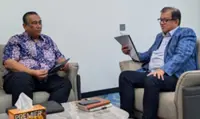There is a beautiful garden at the Kota Kayang Museum in Kuala Perlis. — Photos: FARIDA JAMAL
The roads lined with shady trees and adorned roundabouts added to the joy of our driving vacation to Perlis. Particularly striking was the sculpture of a gilded tree displayed on a roundabout in the centre of Arau. Most Malaysians would immediately recognise it as a replica of the “bunga emas dan perak” (gold and silver flowers) or simply, Bunga Mas.
Much has been written about this artefact and replicas are on display in several museums, including the National Museum. While scholars continue to unravel its significance in Malaysian history, one can learn about Bunga Mas in a more relaxing manner. Inspired by the huge replica shimmering on a hot afternoon in Arau, we headed towards Kota Kayang, the Perlis State Museum.





